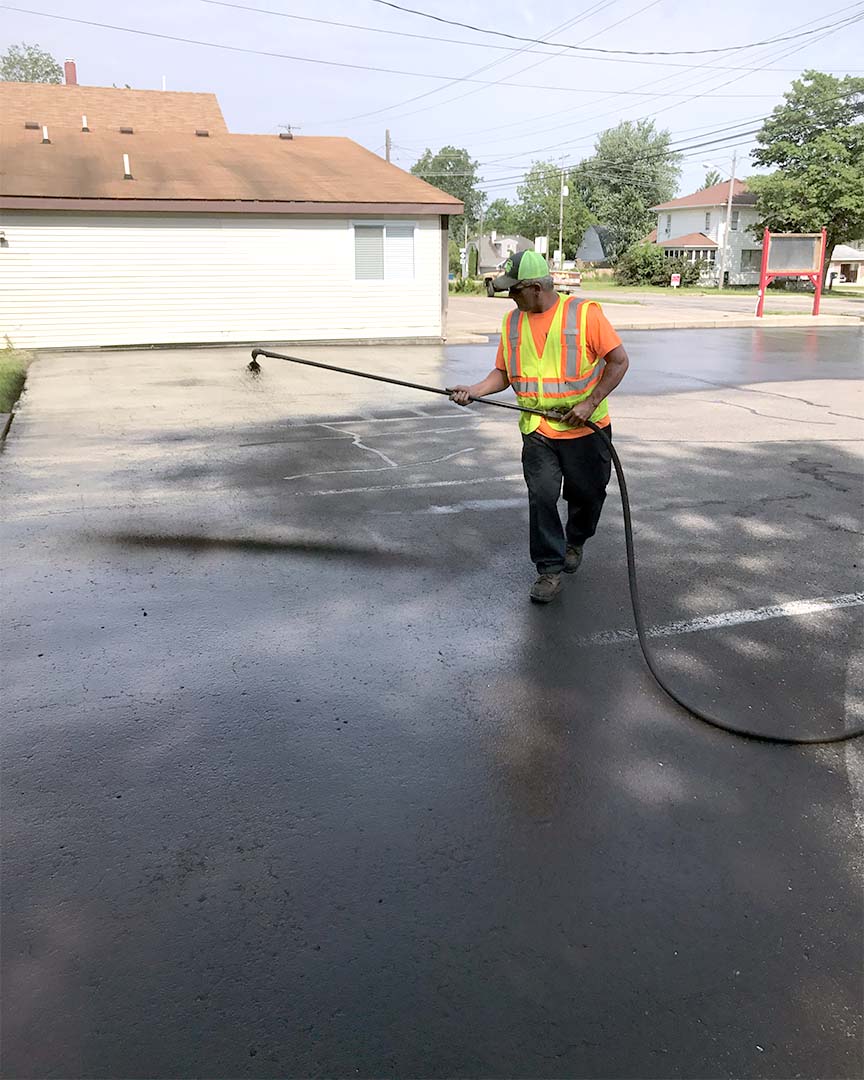Maximize Investment Returns: Angled Car Park Excellence with Asphalt Sealing
Maximize Investment Returns: Angled Car Park Excellence with Asphalt Sealing
Blog Article
Warm Mix Asphalt: A Lasting Option for Sidewalk
Hot Mix Asphalt (HMA) has become a leading sustainable selection for sidewalk remedies, using a myriad of cutting-edge innovations and ecological benefits. Its ability to recycle products and minimize power intake provides a compelling case for its fostering in roadway building jobs. The lasting performance and resilience of HMA make it a preferred alternative for facilities development. As the need for environment-friendly construction techniques grows, exploring the subtleties of HMA's sustainability can offer beneficial understandings into the future of sidewalk solutions.
Environmental Benefits of Warm Mix Asphalt

Furthermore, Warm Mix Asphalt assists to reduce city warmth island results. Its dark shade absorbs sunlight, reducing the amount of warm mirrored back into the environment contrasted to lighter-colored pavements. This can reduce ambient temperature levels in urban areas, lowering the demand for a/c and inevitably reducing energy usage.
On top of that, Hot Mix Asphalt adds to enhanced stormwater administration. Its porous nature enables water to penetrate the sidewalk and reenergize groundwater supplies, reducing runoff and the risk of flooding. These environmental benefits make Hot Mix Asphalt a sustainable choice for paving roads and highways.
Energy Effectiveness in HMA Production
Is energy efficiency a critical variable in the production of Warm Mix Asphalt (HMA)? Power plays a considerable duty in the manufacturing of HMA, impacting both cost and ecological sustainability. One crucial aspect of power effectiveness in HMA manufacturing is the use of cozy mix asphalt (WMA) innovations.
Moreover, developments in plant modern technologies have led to more energy-efficient HMA manufacturing processes. By enhancing power usage in HMA manufacturing, the sector can reduce its carbon footprint while preserving high-quality pavement materials.
Recyclability of Warm Mix Asphalt
The recyclability of Warm Mix Asphalt (HMA) is a crucial aspect of its sustainability and long-lasting ecological influence. HMA is just one of the most recycled materials in the United States, with over 100 million bunches of reclaimed asphalt pavement (RAP) being reused every year in brand-new sidewalk building and construction. Reusing HMA uses numerous environmental benefits, such as lowering the demand for virgin materials, lowering energy consumption during production, and reducing the amount of waste sent to garbage dumps.
The procedure of recycling HMA involves crushing the existing pavement, crushing it right into smaller sized pieces, and mixing it with brand-new accumulation and asphalt binder to produce a recycled mix. In general, the recyclability of HMA plays a considerable role in advertising sustainable practices within the sidewalk market.

Long-Term Efficiency of HMA
Asphalt sidewalks show durability and resilience over an extended period, reflecting the long-term performance of Warm Mix Asphalt (HMA) The long life of HMA can be connected to its capability to hold up against hefty web traffic lots, extreme climate condition, and the effects of aging. Studies have actually shown that properly designed and properly created HMA sidewalks can last for twenty years or more with regular upkeep. The trick to maximizing the long-term efficiency of HMA hinges on using top quality materials, adhering to best techniques in building, and executing effective upkeep methods. Proper water drainage, regular evaluations, and timely fixings are vital for preserving the architectural stability of HMA pavements with time. Furthermore, advancements in HMA modern technology, such as making use of polymer-modified binders and warm mix asphalt, have try this actually even more boosted the longevity and durability of HMA sidewalks. By prioritizing top quality building and upkeep methods, HMA proceeds to verify itself as a sustainable and economical solution for resilient pavement facilities.

HMA: Longevity and Sustainability
Demonstrating both sturdiness and sustainability, Warm Mix Asphalt (HMA) has actually ended up being a keystone in the building of lasting sidewalk frameworks - regrading. HMA's longevity comes from its capacity to stand up to hefty tons, rough weather condition problems, and high traffic quantities, making it a dependable selection for streets, freeways, and airport runways. The make-up of HMA, which generally consists of accumulations, binder, and filler, plays an important duty in enhancing its durability and resistance to damage
Furthermore, HMA's sustainability depends on its recyclability and energy-efficient manufacturing process. The ability to reuse recovered asphalt sidewalk (RAP) in new HMA mixes minimizes the need for virgin products and minimizes the environmental effect of sidewalk building and construction and upkeep. Additionally, the energy effectiveness of creating HMA exists in its reduced blending temperature levels contrasted to other pavement materials, resulting in minimized power intake and greenhouse gas exhausts.
Verdict
Finally, warm mix asphalt (HMA) offers a sustainable service for pavement with its ecologically friendly qualities. HMA's recyclability, energy effectiveness in production, and long-term sturdiness make it a green choice for roadway building and construction. By preserving natural deposits, reducing waste, and lowering greenhouse gas exhausts, HMA plays a crucial role in advertising sustainability in facilities advancement. Its ability to mitigate city warmth island impacts even more underscores its significance in creating environmentally aware and durable pavement systems.
HMA is one of the most recycled materials in the United States, with over 100 million loads of redeemed asphalt pavement (RAP) being recycled every year in new sidewalk construction.The procedure of recycling HMA includes milling the existing sidewalk, squashing it into smaller sized pieces, and blending it with new accumulation you can try here and asphalt binder to create click resources a recycled mix.Asphalt pavements show sturdiness and resilience over a prolonged duration, reflecting the lasting performance of Hot Mix Asphalt (HMA) In addition, improvements in HMA modern technology, such as the use of polymer-modified binders and cozy mix asphalt, have actually even more boosted the resilience and long life of HMA pavements. The capability to recycle recovered asphalt sidewalk (RAP) in new HMA blends reduces the need for virgin materials and decreases the environmental influence of pavement building and construction and maintenance.
Report this page